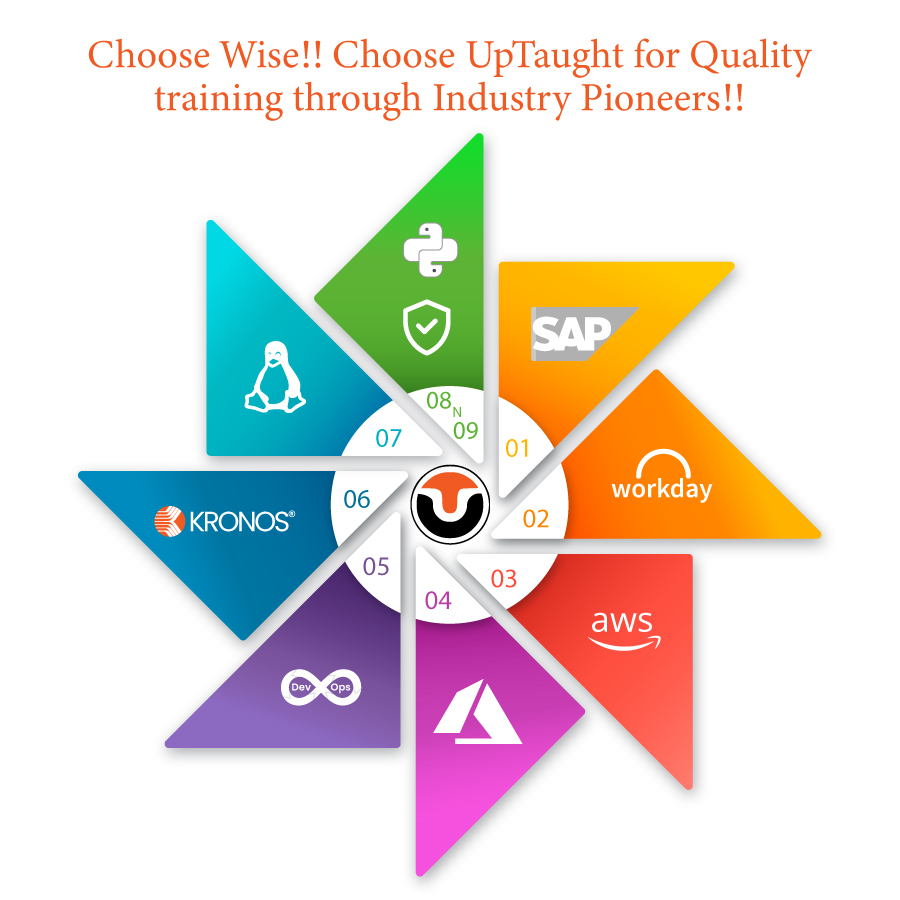AWS Developer Associate Certification Training
Aiming to learn Web Development? Then you are here with the Pioneers of the Developers. With 28+ hours of live online learning and mentoring sessions UpTaught is the preferred choice of technology professionals and we are recognized as the most cost – effective online learning platform for Web Development Courses both learners and educators, designed by experts based on AWS Associate.
-
LevelAll Levels
Start Date
Time
Duration
Type
Mode of Training
Course Curriculum
Module 1 – AWS Cloud Essentials: An overview
-
1. Basic overview of the cloud
-
2. Different types of cloud models
-
3. Different types of cloud services,
-
4. Different vendors of cloud implementation
-
5. Why to choose AWS?
-
6. Features of AWS and key offerings
-
7. Who is using AWS/customers
-
8. Real time Use-cases
-
9. Opportunities in Cloud / Market
Module 2 – AWS Fundamentals
-
1. Basic overview of the cloud
-
2. Different types of cloud models
-
3. Different types of cloud services
-
4. Different vendors of cloud implementation
-
5. Why to choose AWS?
-
6. Features of AWS and key offerings
-
7. Who is using AWS/customers
-
8. Real time Use-cases
-
9. Opportunities in Cloud / Market
Module 3 – AWS Console and Usage
-
1. AWS console, Explain each service visually over the console
-
2. Compute Service
-
3. Storage Service
-
4. Database Service
-
5. Content Delivery Service
-
6. Network Service
-
7. Application Service
-
8. Deploy & Management Service
Module 4 – AWS Software development Kit and command line tool kit
-
1. AWS Java SDK Kit
-
2. Step by step Java SDK installation
-
3. Configuration
-
4. Develop sample java program and access AWS resources
-
5. AWS CLI tool kit
-
6. Step by step Java SDK installation
-
7. Configuration
-
8. Develop sample java program and access AWS resources
Module 5 – Monitoring and Metrics
-
1. Demonstrate ability to monitor availability and performance
-
2. Creating Cloud Watch Alarms
-
3. Installing And Configuring Monitoring Scripts for Amazon EC2 Instances
-
4. Elastic Compute Cloud (EC2) Instance and System Status Checks
-
5. Monitoring EBS For Performance And Availability
-
6. Monitoring RDS For Performance And Availability
-
7. Monitoring The Elastic Load Balancer For Performance And Availability
-
8. Demonstrate ability to monitor and manage billing and cost optimization processes
-
9. AWS Billing And Linking AWS Accounts
-
10. AWS Billing Dimensions and Metrics For Cloud Watch
Module 6 – High Availability
-
1. Implement scalability and elasticity based on scenario
-
2. Scalability And Elasticity Essentials
-
3. Determining Reserved Instance Purchases Based Off Business Needs
-
4. Elastic Load Balancer
-
5. Autoscaling
-
6. What is autoscaling and where to use, how to configure autoscaling & autoscaling groups
-
7. Demo on scale up and scale down scenarios, Ensure level of fault tolerance based on business needs
-
8. High Availability by using Elastic IP Addresses, Understanding RDS Multi-AZ Failover
Module 7 – Analysis and Data Management
-
1. Different storage services
-
2. How to create and attach EBS volumes, EBS Root Devices On Terminated Instances – Ensuring Data Durability
-
3. What is Ephemeral storage? what is the usage? how create and attach s3 bucket
-
4. Demonstrate ability to create backups for different services ( EC2 & RD, how to create a customized AMI
-
5. How to take a snapshot and reuse the AMI
-
6. How to take a backup of the RDS instance
-
7. How to enable to auto snapshots for the RDS instance
-
8. Managing Backup And Disaster Recovery Processes
-
9. Quickly Recovering From Disasters
-
10. Read Replicas With MySQL RDS Across Regions
-
11. Storing Log Files And Backups from glacier service
Module 8 – Security and Networking
-
1. Implement and manage security policies
-
2. S3 Bucket Policies, Building IAM Policies
-
3. Network Access Control Lists (NACLs)
-
4. Using IAM Roles With EC2
-
5. Ensure data integrity and access controls when using the AWS platform
-
6. What is MFA On Amazon Web Services (Multifactor Authentication)
-
7. What is Security Token Service
-
8. Demonstrate ability to prepare for security assessment use of AWS
-
9. Different AWS provided certificates & standards followed at AWS data centers
-
10. How to handle IT Audits, Demonstrate ability to implement networking features of AWS
-
11. Route53 and DNS Failover
-
12. VPC Essentials, Building A Non-Default VPC, VPC Networking, VPC Security, DB Subnet Groups, Elastic IP Addresses And Elastic Network Interfaces
-
13. Configuring A Web Application In VPC
-
14. Building A Virtual Private Cloud From Scratch – VPC
-
15. Troubleshooting Connectivity In Issues, Demonstrate ability to implement connectivity features of AWS
-
16. What is the AWS Direct Connect & On-premise To VPC Redundancy
Module 9 – Deployment and Provisioning
-
1. Demonstrate the ability to provision cloud resources and manage implementation automation
-
2. Creating Our First Stack
-
3. Creating an Amazon Virtual Private Cloud with Cloud Formation And Launching An EC2 Instance
Module 10 – Big Data and Analytics
-
1. What is the usage the EMR and big data concepts
-
2. How to launch and configure the EMR service
-
3. Run a sample MapReduce program to view the job details to analyse the Big data
Module 11 – Cloud Best Practices
-
1. Cloud Security Best Practices at each layer, Compute Service
-
2. Storage Service
-
3. Database Service
-
4. Content Delivery Service
-
5. Network Service
-
6. Application Service
-
7. Deploy & Management Service
Module 12 – Cost Optimization
-
1. Cost Optimization at each layer
-
2. Compute Service
-
3. Storage Service
-
4. Database Service
-
5. Content Delivery Service
-
6. Network Service
-
7. Application Service
-
8. Deploy & Management Service
AWS Developer Associate Certification Training
-
LevelAll Levels

Raj
AWS Certified Database – Specialty (2021)-AWS Solution Architect-Associate (2020)-SAFe Certified Practitioner (2020)-Talend ESB Enterprise (2016)-ITIL FOUNDATION V3 (2011)-Tableau-QlikView-SQL Server-VS.NET
Instructor Description:
- 17+ years of IT experience across AWS Cloud, ETL-BI Tools (Talend, MSBI), Enterprise Architecture, Database Designing, web programming, IT application support, project management, ITIL and SDLC/AGILE.
- 2X Certified AWS Solution Architect, 2X certified Talend Admin/Developer.
- Experienced Corporate Trainer on AWS, Talend (ETL), DB, EX-AWS Authorized Instructor
- Extensive knowledge on real-time scenarios on AWS
- Mentored more than 100 students in AWS developer at the same time
- Excellent communication skills and updates his knowledge technically from time to time
Roadmap
Salary range
FAQs
- In-depth knowledge of at least one high-level programming language.
- Understanding of core AWS services, uses, and basic AWS architecture best practices.
- Proficiency in developing, deploying, and debugging cloud-based applications using AWS.
It is not a prerequisite, it is good to have knowledge of coding as building applications for the cloud and deploying them into the AWS cloud requires programming knowledge.
Of these Amazon Web Services (AWS), skills are the most in-demand skills with 25,361 open jobs. 60% of the cloud-computing job postings ask for skills related to Amazon Web Services.
The answer is a resounding ‘yes’ for AWS is the global choice of the majority when it comes to various products of cloud services and it has created its milestone and built its rand intensity making it a sound service platform
You will have to mark a minimum of 720 points out of 1000 to clear the DVA-C01 exam.
The following are the roles and responsibilities of an AWS Developer:
- Understand the present application infrastructure and recommend modifications to it.
- Define and document best practices and strategies regarding application deployment and infrastructure maintenance.
- Migrate our infrastructure with zero downtime to a highly available, scalable one.
- Create a monitoring stack.
- Define service capacity planning strategies.
- Implement the application’s CI/CD pipeline utilizing the AWS CI/CD stack.
- Write infrastructure as code utilizing CloudFormation or same.
The following are the top AWS Developer skills that every developer must possess:
- Knowledge on programming in various languages.
- Knowledge for cloud computing.
- Familiar with Lambda.
- Familiar with Networking
- Knowledge on virtualization
According to ZipRecruiter, AWS Developers in the United States get an average annual salary of US$122,799.
The following are the reasons that supports the above:
- Expertise In Cloud Computing Is A Must-Have For IT Professionals
- AWS Skills Demand Is Outstripping Supply
- AWS Is massively utilized In Cloud Adoption
- AWS Is widely utilized In Cloud Adoption
- AWS Is extensively utilized In Cloud Adoption
- AWS Skills Are Well Salaried
AWS developers can select between a variety programming languages, including Microsoft, .NET, Java and Python. In order to agree which programming language is more suited for a particular project, it is significant to identify the problem with domain and the local ecosystem.
Your skills and experience will decide how easy or complex you find the exams for the certifications.
The following are the prerequisites required to get this certification:
- Appeared the AWS Essentials course or should have an equivalent experience
- Familiar with developing applications with API interfaces
- Basic understanding of relational and non-relational databases.
Here’s a list of the 15 different career paths that an AWS cloud engineer can take.
- Back-end developer
- Cloud engineer
- Data engineer
- Data scientist
- Development operations engineer
- Front-end developer
- Full-stack developer
- Java developer
- .NET developer
- Senior Java developer
- Senior software engineer
- Software architect
- Systems administrator
- Software engineer
- System engineer
AWS may be simply easier for you to learn. However, no previous experience, specialist knowledge, or programming experience is required to learn AWS.
For a level of AWS Developer, it takes a minimum of 2-3 months.





